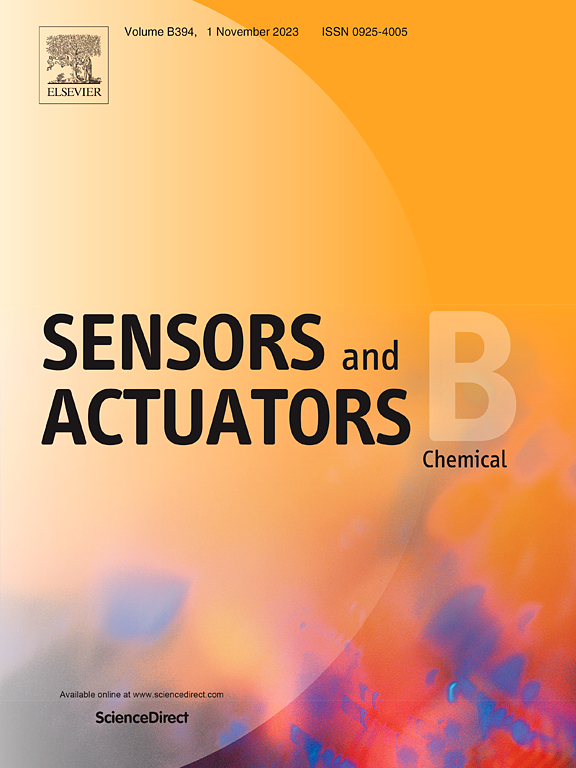聚合诱导和协同加速双增强电化学发光法测定对乙酰咪啶
IF 3.7
1区 化学
Q1 CHEMISTRY, ANALYTICAL
引用次数: 0
摘要
开发具有优异分析性能的电化学发光(ECL)系统用于痕量分析物的灵敏检测是一项极具挑战性的工作。本文以锌离子诱导的3,4,9,10-苝四羧酸(Zn - PTC)为发光团,过硫酸钾(K2S2O8)为助反应剂,Au@MnCo2O4为助反应促进剂,采用聚合诱导和助反应促进剂相结合的方法,建立了一种高效的ECL系统,用于检测痕量啶虫啉。在K2S2O8存在下,PTC未表现出明显的ECL信号,而Zn - PTC在−1.6 V左右表现出明显的ECL信号。Au@MnCo2O4纳米材料作为共反应促进剂可使Zn−PTC的ECL信号增强4倍,这主要是由于以下三个方面:1)Zn−PTC与Zn2+诱导的PTC聚集不仅消除了PTC分子间聚集诱导的猝灭效应,而且产生了新的金属-配体电荷转移效应,将Zn2+的能量转移到PTC配体上,从而增强了ECL信号。ii) Au@MnCo2O4由于Au@MnCo2O4中Mn2+/Mn3+和Co2+/Co3+优异的可逆氧化还原性能,可以加速S2O82−和H2O的电化学还原,产生大量的活性自由基,增强ECL信号。iii) Au@MnCo2O4作为一种令人满意的纳米载体,可以固定更多的Zn - PTC,从而进一步增强ECL信号。利用Zn - PTC/S2O82−/Au@MnCo2O4所开发的ECL系统的优异性能,所开发的ECL感应传感器具有5 ~ 100 nM的宽线性范围和1.22 fM的低检出限。正如预期的那样,所提出的ECL感应传感器成功地应用于实际样品中对啶虫脒的检测,并取得了理想的结果。本研究结合双信号放大策略有效地增强了ECL,为构建复杂基质物种靶点的痕量检测传感器提供了新的视角和方法。本文章由计算机程序翻译,如有差异,请以英文原文为准。

Dual enhanced electrochemiluminescence using aggregation induction and coraction accelerator strategies for trace determination of acetamiprid
Developing electrochemiluminescence (ECL) systems with excellent analytical performance for sensitive detection of trace analytes is highly challenging. Herein, a high-performance ECL system for sensitive detection of trace acetamiprid was developed using a combination of aggregation induction and coreactant accelerator strategy with zinc ions-induced 3,4,9,10-perylenetetracarboxylic (Zn−PTC) as luminophore, potassium persulfate (K2S2O8) as coreactant and Au@MnCo2O4 as coreaction accelerator. In the presence of K2S2O8, PTC fail to exhibited an obvious ECL signal, while Zn−PTC showed a significant ECL signal around −1.6 V. Au@MnCo2O4 nanomaterial as the coreaction accelerator could be enhanced the ECL signal of Zn−PTC by 4 times, which is mainly due to the following three aspects: i) Zn−PTC with Zn2 +-induced PTC aggregation not only eliminates the aggregation-induced quenching effect between PTC molecules, but also has a new metal-to-ligand charge-transfer effect, which could transfer the energy of Zn2+ to the PTC ligand, thereby enhancing the ECL signal. ii) Au@MnCo2O4 could accelerate the electrochemical reduction of S2O82− and H2O to generate a large amount of active free radicals for enhancing ECL signal because the excellent reversible redox properties of Mn2+/Mn3+ and Co2+/Co3+ in Au@MnCo2O4. iii) Au@MnCo2O4 acted as a satisfying nanocarrier to immobilize more Zn−PTC thereby further enhancing ECL signal. Benefitting from the fabulous performance of the developed ECL system from Zn−PTC/S2O82−/Au@MnCo2O4, the developed ECL aptasensor for detecting acetamiprid exhibits a wide linear range from 5 to 100 nM as well as a low detection limit of 1.22 fM. As expected, the proposed ECL aptasensor was triumphantly applied to detect acetamiprid in actual samples with desirable results. This work integrated dual signal amplification strategies to effectively enhance ECL, which provided a novel perspectives and approaches to constructing sensors for trace detection of complex matrix species targets.
求助全文
通过发布文献求助,成功后即可免费获取论文全文。
去求助
来源期刊

Sensors and Actuators B: Chemical
工程技术-电化学
CiteScore
14.60
自引率
11.90%
发文量
1776
审稿时长
3.2 months
期刊介绍:
Sensors & Actuators, B: Chemical is an international journal focused on the research and development of chemical transducers. It covers chemical sensors and biosensors, chemical actuators, and analytical microsystems. The journal is interdisciplinary, aiming to publish original works showcasing substantial advancements beyond the current state of the art in these fields, with practical applicability to solving meaningful analytical problems. Review articles are accepted by invitation from an Editor of the journal.
 求助内容:
求助内容: 应助结果提醒方式:
应助结果提醒方式:


